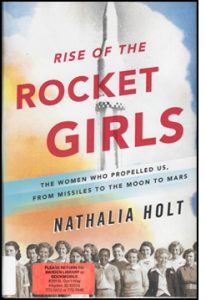 There ought to be at least one copy of this book in every high school library and public library in the United States.
There ought to be at least one copy of this book in every high school library and public library in the United States.
Through diligent and thorough research, masterful storytelling, and skillful writing, author Dr. Nathalia Holt introduces readers to the women who did the math behind the United States’ missile and space programs. They were computers.
“Before Apple, before IBM, and before our modern definition of a central processing unit partnered with memory, the word computer referred simply to a person who computes. Using only paper, a pencil, and their minds, these computers tackeled complex mathematical equations.” (p. 13)
Rise of the Rocket Girls is the personal and professional stories of women who were computers at the Army’s Air Corps Jet Propulsion Research Project in Pasadena, California. It was the beginning of what would become the Jet Propulsion Laboratory (JPL). Some of the women were there from the early 1940’s during the days preceding 1958 when the Army handed over control of JPL to the National Aeronautics and Space Administration (NASA).
We suspect many readers will recognize the names Theodore von Kármán and Wernher von Braun and easily associate them with early US rocket science. Fewer will recognize Barby Canright, Macie Roberts, and Barbara (Lewis) Paulson. Yet had it not been for these Rocket Girls and the others including Janez Lawson, Helen (Yee Chow) Ling, Susan Finley, and Sylvia (Lundy) Miller, the US might not have put men on the moon and brought them home safely. We might never have had Pathfinder that put the rovers Sojourner, Spirit, Opportunity, and Curiosity on Mars.
But why should Dr. Holt’s book be in every high school library in the United States? Because Dr. Holt includes not just the historical information about the Rocket Girls. She includes enough science and the discussion of the importance and relevance of math and science to also remind us of the importance the first Rocket Girls’ work done with “only paper, a pencil, and their minds” at JPL.
Those of us who struggle balancing our personal checkbooks can barely fathom the complexity and number of the Rocket Girls’ calculations needed to deliver a rocket to a planet millions of miles away, then place scientific instruments exactly where they need to be on that planet, then position a massive earth antenna to receive the data sent back from the low-power telemetry equipment.
When the first room-filling electronic computers found their way into JPL, it was the Rocket Girls’ knowledge of mathematics and the mission that enabled them to make the smooth transition from paper and pencil to FORTRAN.
This book is very readable. It tells the story of the Rocket Girls, the women doing the math behind the US’s missile and rocketry development programs. It talks of the CalTech Suicide Squad and the lovely and talented contestants for the Miss Guided Missile award. It is inspiring.
